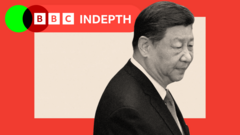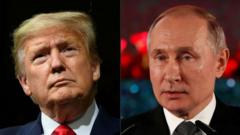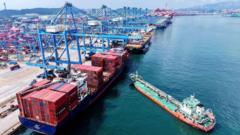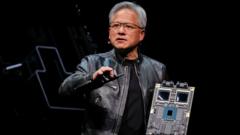China's economy is wrestling with deepening internal challenges, which are becoming more critical than tariffs imposed by former President Donald Trump. A notable housing crisis, rising job insecurities, and a declining consumer outlook threaten President Xi Jinping's vision of a rejuvenated China.
### Xi's Economic Aspirations Face New Challenges Beyond Trump’s Tariffs

### Xi's Economic Aspirations Face New Challenges Beyond Trump’s Tariffs
Despite the threat of tariffs, Chinese leaders remain focused on overcoming domestic economic issues.
China trades with over 145 nations, shifting focus from the U.S., as domestic policies aim to stimulate spending despite fears of an unsustainable recovery, leaving Xi with an uncertain legacy.
As President Xi Jinping's ambition for a revitalized China is tested, the shadow of Donald Trump's ambitious tariffs looms but does not instill fear among Chinese entrepreneurs. Instead, it fuels a wave of nationalistic digital satire mocking the ex-president. The U.S. tariffs, set at an eye-watering 145%, have pushed Chinese internet users to craft imaginative memes featuring Trump and other prominent figures, mocking the perceived difficulties imposed by these sanctions.
Yet, the larger contextual backdrop reveals a much less buoyant economic landscape within China. Xi's leadership, which began with dreams of prosperity in 2012, now grapples with a struggling economy exacerbated not only by external pressures but more so by internal strife. The Chinese populace, particularly in urban centers, is increasingly reluctant to spend amidst rising job insecurity and a noteworthy collapse in the housing market.
As it stands, many Chinese families invested their life savings into properties which have drastically lost value, leading to a marked decline in consumer spending. In fact, estimates indicate there could be enough vacant housing in the country to accommodate an entire population of 3 billion, dwarfing its 1.4 billion residents. Former officials have likened the expansion to "ghost cities," deserted developments that lay empty despite flashy exits.
Concerns regarding future security are just as prevalent, as the aging population poses significant pension risks with the government pension fund projected to run out by 2035. The youth unemployment rate has hit staggering highs, with over 20% of urban young people unable to find work, which aggravates generational anxieties about economic stability.
Xi and his administration face mounting pressure to find solutions that not merely alleviate the sting of potential tariffs but also restore public confidence amid these looming concerns. Recent government initiatives, including incentives for increased spending and enhanced childcare benefits, illustrate attempts to spur domestic consumption. However, experts show skepticism about the sustainability of such measures without significant fundamental change in wages and income.
In parallel, the geopolitical landscape presents an opportunity for China to deepen its ties with alternative markets, particularly through initiatives in South East Asia and beyond, reminiscent of shifts witnessed during Trump's initial term. Actions driven by uncertainty could liberate up to 20% of Chinese exports currently bound for U.S. markets, as Beijing seeks to fortify its position against external disturbances. This could resound as both a diplomatic maneuver and a calculated pivot towards self-reliance.
Although Xi’s narrative over the decade suggested an unstoppable rise, the current volatility necessitates introspection. The unfolding challenges are likely to shape not just the fabric of Chinese society but also Xi's legacy, compelling him to transform potential setbacks into avenues for growth to fortify domestic resilience against future external pressures.
As President Xi Jinping's ambition for a revitalized China is tested, the shadow of Donald Trump's ambitious tariffs looms but does not instill fear among Chinese entrepreneurs. Instead, it fuels a wave of nationalistic digital satire mocking the ex-president. The U.S. tariffs, set at an eye-watering 145%, have pushed Chinese internet users to craft imaginative memes featuring Trump and other prominent figures, mocking the perceived difficulties imposed by these sanctions.
Yet, the larger contextual backdrop reveals a much less buoyant economic landscape within China. Xi's leadership, which began with dreams of prosperity in 2012, now grapples with a struggling economy exacerbated not only by external pressures but more so by internal strife. The Chinese populace, particularly in urban centers, is increasingly reluctant to spend amidst rising job insecurity and a noteworthy collapse in the housing market.
As it stands, many Chinese families invested their life savings into properties which have drastically lost value, leading to a marked decline in consumer spending. In fact, estimates indicate there could be enough vacant housing in the country to accommodate an entire population of 3 billion, dwarfing its 1.4 billion residents. Former officials have likened the expansion to "ghost cities," deserted developments that lay empty despite flashy exits.
Concerns regarding future security are just as prevalent, as the aging population poses significant pension risks with the government pension fund projected to run out by 2035. The youth unemployment rate has hit staggering highs, with over 20% of urban young people unable to find work, which aggravates generational anxieties about economic stability.
Xi and his administration face mounting pressure to find solutions that not merely alleviate the sting of potential tariffs but also restore public confidence amid these looming concerns. Recent government initiatives, including incentives for increased spending and enhanced childcare benefits, illustrate attempts to spur domestic consumption. However, experts show skepticism about the sustainability of such measures without significant fundamental change in wages and income.
In parallel, the geopolitical landscape presents an opportunity for China to deepen its ties with alternative markets, particularly through initiatives in South East Asia and beyond, reminiscent of shifts witnessed during Trump's initial term. Actions driven by uncertainty could liberate up to 20% of Chinese exports currently bound for U.S. markets, as Beijing seeks to fortify its position against external disturbances. This could resound as both a diplomatic maneuver and a calculated pivot towards self-reliance.
Although Xi’s narrative over the decade suggested an unstoppable rise, the current volatility necessitates introspection. The unfolding challenges are likely to shape not just the fabric of Chinese society but also Xi's legacy, compelling him to transform potential setbacks into avenues for growth to fortify domestic resilience against future external pressures.


















